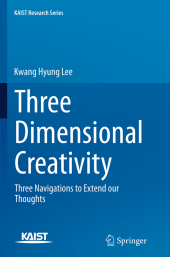 Neuerscheinungen 2016Stand: 2020-02-01 |
Schnellsuche
ISBN/Stichwort/Autor
|
Herderstraße 10
10625 Berlin
Tel.: 030 315 714 16
Fax 030 315 714 14
info@buchspektrum.de |

Kwang-Hyung Lee
Three Dimensional Creativity
Three Navigations to Extend our Thoughts
Softcover reprint of the original 1st ed. 2014. 2016. x, 87 S. 94 SW-Abb. 235 mm
Verlag/Jahr: SPRINGER NETHERLANDS; SPRINGER 2016
ISBN: 9402407839 (9402407839)
Neue ISBN: 978-9402407839 (9789402407839)
Preis und Lieferzeit: Bitte klicken
This book examines a systematic method for developing creativity. It deals with the theoretical and practical aspects of time, space and field to explore how creativity is something that an individual can hone with effort.
Is creativity something that we are simply born with and cannot hone with effort? Some say that creativity cannot be cultivated. Is it true? In general our thinking sticks to reality unless there is any external stimulation. With our thinking fixed on a certain situation, it becomes difficult to come up with a fresh idea. In this regard, three questions are suggested: (1) Question of Time: When a problem arises, question yourself on a time axis first of all. How would the matter be handled 10 or 20 years from now? (2) Question of Space: Ask yourself some questions on its spatial elements. How would the matter be handled in Saudi Arabia or in China? (3) Question of Field: Apply the given problem in a variety of fields. How would the matter be handled in the field of music or electronic engineering?
The three questions suggested here are given on the three axes: time, space, and field, and this book deals with theoretical and practical aspects on the topics. In this way it is a unique book about the systematic method of developing creativity, which will have appeal to researchers and students in multidisciplinary fields from neuroscience to physics, and engineering and computer science, as well as a general public.
Preface.
Chapter 1 Creativity can be cultivated. 1.1 Creativity starts with asking questions. 1.2 Methodology for developing creativity. 1.3 Extend your thoughts guided by the three dimensional navigation. 1.4 Creativity made by a neural circuit. 1.5 Foresight of futures.
Chapter 2 Freedom from time. 2.1 Time axis traveling. 2.2 T1: transpose. 2.3 T2: tempo. 2.4 T3: translation. 2.5 Designing the future. 2.6 The founding of Nexon.
Chapter 3 Freedom from space. 3.1 Space travel. 3.2 S1: shape. 3.3 S3: site. 3.4 S4: size. 3.5 A lesson of Cyworld. 3.6 Globalization of Nexon. 3.7 Globalized thinking.
Chapter 4 Freedom from field. 4.1 Field travel. 4.2 F1: function. 4.3 F2: fertileness. 4.4 F3: fusion. 4.5 Hyundai card benchmarking. 4.6 The discipline of division convergence. 4.7 Misjudgement in the history that resulted from obsession. 4.8 Welcoming, tolerating, and amalgamating things.
Chapter 5 Traveling on a two-dimensional plane. 5.1 A plane that involves two axes. 5.2 Rules in combination of time and space. 5.3 Rules in combination of time and field. 5.4 Rules in combination of space and field. 5.5 Innovation of Steve Jobs. 5.6 Science education that helps learners understand why they learn.
Chapter 6 Traveling in a three-dimensional world. 6.1 Ideas in the three-dimensional world. 6.2 The three-dimensional future-oriented strategy of K-pop music. 6.3 The left hand law of creativity. 6.4 Circuit of brain cells. 6.5 Habits are a product of neural circuits. 6.6 Watching TV upside down. 6.7 Make yourself more creative.


